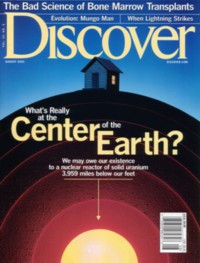Ah...ummm...welll...cough cough...
The Discover Magazine??? Check out their website...
AUGUST 2002 HIGHLIGHTS
COVER STORY
Nuclear Planet By Brad Lemley
Geophysicists have long assumed that the center of Earth is just a big hot ball of iron and nickel. But a bold new theory suggests we are perched atop a gigantic fission reactor fueled by a five-mile-wide core of solid uranium.
Nuclear Planet
Is there a five-mile-wide ball of hellaciously hot uranium seething at the center of the Earth?
By Brad Lemley
What is Earth? Poets say it's a celestial sapphire, a cerulean orb. Astronomers say it's a medium-size planet orbiting an average star. Some environmentalists say it's Mother. Biologists say it's life's only known home. But the most scientifically precise definition may prove to be the one that no one suspected. Earth, says geophysicist J. Marvin Herndon, is a gigantic natural nuclear power plant. We live on its thick shield, while 4,000 miles below our feet a five-mile-wide ball of uranium burns, churns, and reacts, creating the planet's magnetic field as well as the heat that powers volcanoes and continental-plate movements. Herndon's theory boldly contradicts the view that has dominated geophysics since the 1940s: that Earth's inner core is a huge ball of partially crystallized iron and nickel, slowly cooling and growing as it surrenders heat into a fluid core. Radioactivity, in this model, is just a supplementary heat source, with widely dispersed isotopes decaying on their own, not concentrated.
Full text of this article can be found in the current issue of Discover Magazine.
Scientific Papers by J. Marvin Herndon on Planetary Nuclear Fission Reactors
J. M. Herndon (1992) Nuclear fission reactors as energy sources for the giant outer planets. Published in English in the German journal,
Naturwissenschaften, vol. 79, pp 7-14.
J. M. Herndon (1993) Feasibility of a nuclear fission reactor at the center of the earth as the energy source for the geomagnetic field. Published in English in the Japanese journal,
Journal of Geomagnetism and Geoelectricity, vol. 45, pp 423-437.
J. M. Herndon (1994) Planetary and protostellar nuclear fission; implications for planetary change, stellar ignition and dark matter. Published in the British journal, Proceedings of the Royal Society of London, series A, vol. 445, pp. 453-461.
J. M. Herndon (1996) Sub-structure of the inner core of the earth. Published in the American journal, Proceedings of the
National Academy of Sciences (USA), vol. 93, pp. 646-648.
J. M. Herndon (1998) Composition of the deep interior of the earth: divergent geophysical development with fundamentally different geophysical implications. Published in English in the international journal, Physics of the Earth and Planetary Interiors, vol. 105, p.1-4.
J. M. Herndon (1998) Examining the overlooked implications of natural nuclear reactors. Published in the American journal, Eos,
Transactions of the American Geophysical Union, vol. 79, no. 38, pp. 451, 456. [see text]
D. F. Hollenbach and J. M. Herndon (2001) Deep-earth reactor: nuclear fission, helium, and the geomagnetic field. Published in the American journal, Proceedings of the
National Academy of Sciences (USA), vol. 98, no. 20, pp. 11085-11090.
Scientific Papers by J. Marvin Herndon on Deep-Earth Composition
J. M. Herndon (1979) The nickel silicide inner core of the Earth. Published in the British journal, Proceedings of the Royal Society of London, series A, vol. 368, pp. 495-500.
J. M. Herndon (1980) The chemical composition of the interior shells of the Earth. Published in the British journal, Proceedings of the Royal Society of London, series A, vol. 372, pp. 149-152.
J. M. Herndon (1982) The object at the centre of the Earth. Published in English in the German journal, Naturwissenschaften, vol. 69, pp 34-37.
J. M. Herndon (1993) Feasibility of a nuclear fission reactor at the center of the earth as the energy source for the geomagnetic field. Published in English in the Japanese journal, Journal of Geomagnetism and Geoelectricity, vol. 45, pp 423-437.
J. M. Herndon (1996) Sub-structure of the inner core of the earth. Published in the American journal, Proceedings of the National Academy of Sciences (USA), vol. 93, pp. 646-648.
J. M. Herndon (1998) Composition of the deep interior of the earth: divergent geophysical development with fundamentally different geophysical implications. Published in English in the international journal, Physics of the Earth and Planetary Interiors, vol. 105, p.1-4.

